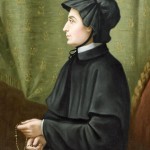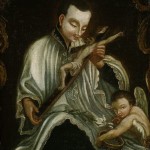St Ignatius of Loyola
The Catholic Church is made up of so many men and women who started out a far cry from God but who then developed a deep passionate love for him. St. Ignatius Loyola was just such a one. He came from a noble family in Azpeitia, Northern Spain. He was the youngest of thirteen children and therefore probably rather spoilt. At the age of sixteen he was sent to serve as a page to Juan Velazques. It was here that he grew to really love the high life. Wine, women and song was the order of the day with plenty of gambling thrown in for good measure. Ignatius was also not against a good sword fight which got him into a lot of hot water on more than one occasion.
Eventually at the age of thirty he became a solider and found himself defending the fortress town of Pamplona against the French. It was here that he was seriously injured. A cannon ball flew through his legs, seriously wounding one leg and breaking the bones in the other. With Ignatius injured the city surrendered and the French took command. Ignatius bravely underwent an operation without any form of anesthetic which impressed the French. Because of his bravery they decided he could recuperate at the castle of Loyola instead of in prison.
Coming very close to death from his injuries it appears a miracle took place on the feast of Saint Peter and Saint Paul. Ignatius turned a corner and his slow journey to recovery began. It was during this time of convalescence that Ignatius began to experience a deep conversion. After asking for some lighthearted romantic novels to read he was given the life of Christ and a book on the Saints. He became absorbed by them and though he often daydreamed about his former life he realized he did not feel peaceful when he had these thoughts, but when he turned his mind to Jesus he became filled with peace and joy, this experience became the basis from which he later began to form his spiritual exercises.
As soon as he was well enough he decided to head for the Holy Land. Ignatius wanted to live in the land that Our Lord God had lived in while here on earth. While on route to Jerusalem he visited the Benedictine monastery of Our Lady of Montserrat. It was here that he made his confession. He stayed all night in front of Our Lady’s altar and like all good knights he gallantly laid his sword and knife on the altar. In the morning he went outside and gave his fine clothes to a beggar and dressed himself in some very rough clothes and sandals and made himself a staff.
As he continued his journey he came upon a town called Maresa. Staying in a cave on the outskirts Ignatius experienced a vision from God. Not much is known about this experience but it was to have a profound effect on the young man’s life. While he was there he began to formulate the spiritual exercises for which he is famous. He also undertook many extreme forms of penance, trying always to outdo those great Saints he had read about when he was recuperating.
His efforts to get to the Holy Land were thwarted by the Superior General of the Franciscans, who because of the many dangers in the Holy Land refused to allow Ignatius to go on with his journey. Faced with excommunication if he violated the superior’s request Ignatius decided to head back to Barcelona. He determined to return to school to improve his Latin so that he could help others. Begging along the way to help him collect money for his education he went to the University of Alcala. Here his zeal for teaching the gospels landed him in hot water. Twice he ended up in prison.
He headed for Paris and it was there that he met his future companions who would help him found his order. Francis Xavier, who by all accounts was a hard nut for him to crack as he to loved the high life, Peter Faber and James Laynez. During his time in Paris Ignatius influenced a number of the students. He taught them his spiritual exercises and six of them decided to take on vows of poverty and chastity.
These six decided that they would travel to the Holy Land. If they couldn’t get there they would go to Rome and offer themselves to the Holy Father so that he may use them as he saw fit. Trying to get to the Holy Land proved impossible so Ignatius and two others, Peter Faber and James Laynez, decided to head for Rome. Just before entering the city Ignatius had his second most significant experience. God told him that “he would be favorable in Rome”. Ignatius, not sure what this meant, met with Pope Paul III.
During the following Lent Ignatius asked all his companions to join him in Rome to discuss their future. While they were there on the feast of St. John the Baptist he and his companions were ordained priests. However it was to be eighteen months before Ignatius was able to bring himself to say his first Mass.
After a number of setbacks and much debate this small band of men decided to formalize their group into a recognizable order, they were to be known as the “Company of Jesus”. When the official documents came from Rome the title given them was “Societas Jesu” which gives the letters “SJ”.
His fellow companions voted that Ignatius should become superior general, much to his discontent. On Friday April 22nd 1541 at the church of St. Paul outside the walls the friends pronounced their vows in the newly formed order.
Ignatius loved to teach everyone their catechism. He worked hard to overcome the problems of the reformation, and he liked to be amongst the poor and sick in the hospitals. But as Superior General his time was taken up in directing the new society which was beginning to flourish throughout the world. It is known that he wrote seven thousand letters personally, however he did have to take on a secretary to help him as he could not keep up with the demands of his role.
Perhaps the best known work of the Society of Jesus began by Ignatius is that of education. Before 1548 Ignatius had opened schools in Italy, Portugal, Netherlands, Spain, Germany and India. Primarily they were for new recruits to the Jesuit order, but before long he was being asked to open schools for everyone. Ignatius used this to stem the decline of the Church in the face of the Reformation.
Throughout most of his adult life Ignatius had suffered with stomach ailments. These suddenly developed into something much worse and becoming very ill Ignatius asked his secretary to get a Papal Blessing. His secretary decided to delay, as he had many letters to write, but just after midnight Ignatius took a turn for the worst and the secretary decided he must run for the blessing; but it was too late – Ignatius went home to God before he returned.
To celebrate in the family why not make some really tasty Spanish Churros, the kids will love them!
Spanish Churros
Ingredients
50g butter, melted
½ tsp vanilla extract
250g plain flour
1 tsp baking powder
about 1 litre sunflower oil
For the sauce
200g bar dark chocolate, broken into chunks
100ml double cream
2 tbsp golden syrup
For the cinnamon sugar
100g caster sugar
2 tsp cinnamon
Boil the kettle, then measure 350ml boiling water into a jug.
Add the melted butter and vanilla extract.
Sift the flour and baking powder into a big mixing bowl with a big pinch of salt.
Make a well in the centre, then pour in the contents of the jug and very quickly beat into the flour with a wooden spoon until lump-free.
Rest for 10-15 mins.
To maker the chocolate sauce.
Put all the sauce ingredients into a pan and gently melt together, stirring occasionally until you have a smooth shiny sauce. Keep warm on a low heat.
Fill a large deep saucepan one-third full of oil.
Cover a tray with kitchen paper and mix the caster sugar and cinnamon together.
Fit a star nozzle to a piping bag, 1.5-2cm wide.
Fill with the rested dough, then pipe 2-3 strips directly into the pan, snipping off each dough strip with a pair of kitchen scissors.
Fry until golden brown and crisp, then remove with a slotted spoon and drain on the kitchen paper-lined tray.
Cook the rest of the dough in batches, sprinkle the cooked churros with some cinnamon sugar when they come out of the oil.
Serve with the chocolate sauce.
Tags: St Ignatius

















